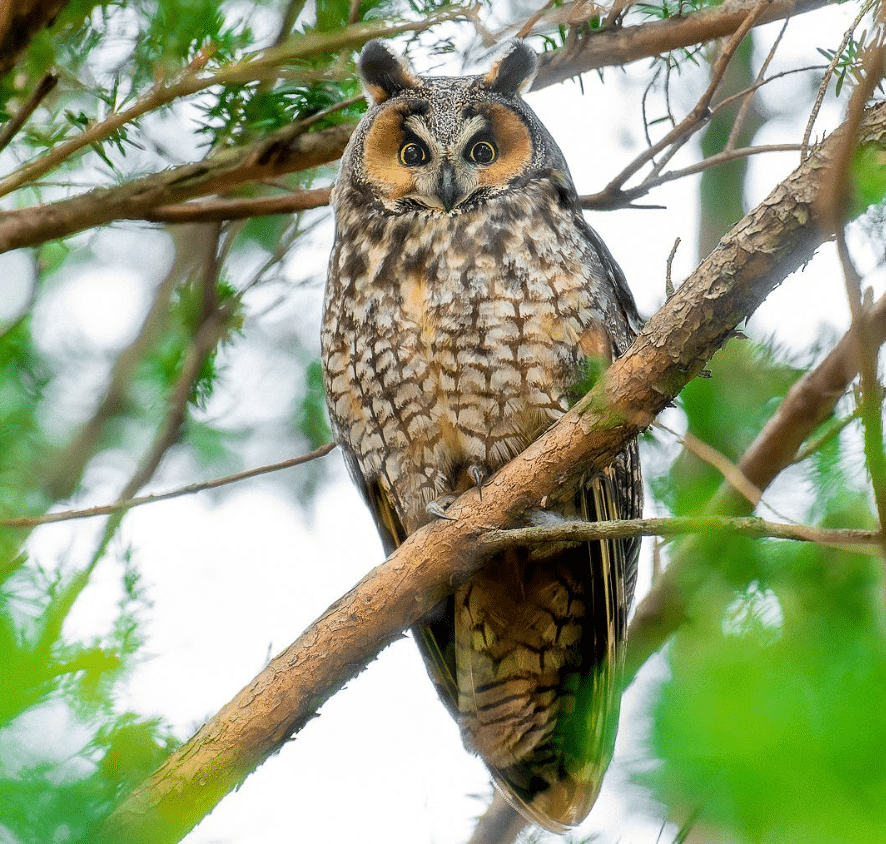The Long-Eared Owl (Asio otus) is a species of owl belonging to the family Strigidae. This article provides an overview of the taxonomy and classification, physical characteristics, habitat and distribution, behaviour and feeding habits, as well as the conservation status and threats faced by the Long-Eared Owl. By adhering to an academic style that is objective and impersonal, this article aims to present a comprehensive understanding of this avian species without personal biases or subjective opinions.
Taxonomy and Classification of Long-Eared Owl
The taxonomy and classification of the long-eared owl can be determined by examining its morphological characteristics, vocalisations, and genetic analysis. Long-eared owls belong to the family Strigidae, which includes around 200 species of owls. Within this family, they are classified under the genus Asio and species otus. The long-eared owl is characterised by its long ear tufts, which are not actual ears but rather feathers that help in camouflage and communication. In terms of size, they are medium-sized owls with a wingspan averaging between 90-100 cm. Their plumage is mottled brown with streaks of white, providing excellent camouflage against tree bark or foliage during daylight hours. Long-eared owls produce a variety of vocalisations including hoots, barks, screeches, and hisses for communication purposes such as territorial defence or courtship displays. Genetic analysis has also aided in clarifying their taxonomic relationships within the owl family.
Natural predators of the long-eared owl include larger raptors such as great horned owls (Bubo virginianus) and northern goshawks (Accipiter gentilis). These predators pose a significant threat to long-eared owl populations due to their ability to outcompete them for resources or directly prey upon them. Additionally, mammals like red foxes may also occasionally prey on young or injured individuals when given the opportunity. Understanding the natural predators of long-eared owls is crucial for assessing their ecological interactions and implementing conservation measures to ensure their survival in various habitats across their range.
Physical Characteristics of the Long-Eared Owl
Characterised by prominent tufts on its head, the long-eared owl possesses a wingspan that ranges between 85 and 100 centimetres. This particular species of owl is known for its distinctive appearance. The long-eared owl has a slim body with a length of about 33 to 40 centimetres. It has large, round facial discs, which help in directing sound towards its ears, aiding in hunting prey. The plumage of the long-eared owl is usually brown or reddish-brown with dark streaks and pale underparts. Its eyes are bright yellow and set within dark feather patches called “ear tufts”. These ear tufts are not actual ears but are rather used for communication and camouflage purposes.

Habitat and Distribution of the Long-Eared Owl
Prominently found in various parts of North America, Europe, and Asia, the long-eared owl is known to inhabit a diverse range of habitats. These owls are typically found in forested areas, including coniferous and deciduous forests, as well as mixed woodlands. They also inhabit shrublands, marshes, grasslands, agricultural fields, and even urban parks and gardens. The distribution of long-eared owls is widespread across their range but can be patchy due to the availability of suitable habitat.
In North America, they are found throughout much of the continent, from Alaska and Canada down to Mexico. In Europe and Asia, they have a broader distribution and can be found from Scandinavia to Japan. However, their numbers vary in different regions depending on factors such as prey availability and habitat fragmentation. Overall, the long-eared owl’s adaptability allows it to thrive in a variety of habitats across its vast distribution range.
Behaviour and Feeding Habits of the Long-Eared Owl
The behaviour and feeding habits of the long-eared owl are influenced by factors such as prey availability, habitat structure, and environmental conditions. Long-eared owls are solitary birds and have limited social interactions. They prefer to hunt alone, perching on low branches or flying low over open habitats in search of small mammals such as voles, mice, and shrews. These owls employ various hunting techniques to capture their prey.
One common technique is known as sit-and-wait predation, where they patiently wait for an opportunity to strike at unsuspecting prey from a concealed location. Long-eared owls also use their excellent hearing capabilities to locate prey in the dark using sound cues. Once caught, they consume their prey whole or tear it into smaller pieces before swallowing.
Conservation Status and Threats to the Long-Eared Owl
The conservation status of the long-eared owl is a concern due to various threats it faces in its natural habitat. Conservation efforts are being made to protect this species and ensure its survival. One of the main threats to the long-eared owl is human disturbance. Human activities such as habitat destruction, deforestation, and urbanisation can disrupt the owl’s nesting sites and foraging areas. This can lead to a decline in their population size and overall reproductive success. In addition, noise pollution caused by human activities can interfere with their ability to communicate and locate prey, further impacting their survival. To address these issues, conservation organisations are working towards creating protected areas, implementing regulations to limit human disturbance, and raising awareness about the importance of preserving the long-eared owl’s habitat.
Conclusion
The long-eared owl (Asio otus) is a species of owl belonging to the family Strigidae. It is characterised by its long ear tufts, yellow eyes, and mottled brown plumage. The long-eared owl can be found in various habitats across North America, Europe, and Asia. It primarily feeds on small mammals and birds, using its excellent hearing and silent flight to locate prey. Unfortunately, the long-eared owl faces threats such as habitat loss and fragmentation. Conservation efforts are crucial for the survival of this species.
Additional Resources
Sam loves to learn about animals and their habitats. He has been a nature lover from a very young age, and has been writing papers and articles about wildlife for as long as he can remember.

I have a long ears owl in my wood it roosts beside a bird feeder.